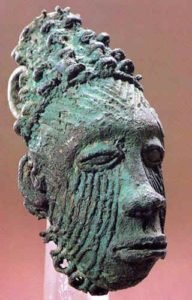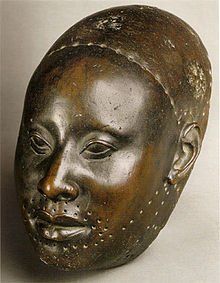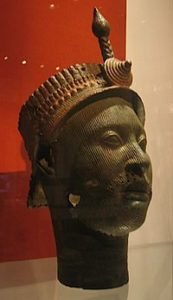A Comprehensive History of Art in Nigeria
The history of Nigerian art brings to mind names like Chief Aina Onabolu, Ben Enonowu, Yussuf Grillo Prof Bruce Onabrekpeya amongst others. These men are regarded as the fathers of modern art in Nigeria, with Chief Onabolu being the father of them all, and also he’s been considered the first art teacher in Nigeria.
If there’s modern art, it would invariably mean that there’s ancient art. That is what we’d be looking at. Art had existed in this region of the world before the fathers of art were born. And they didn’t invent art, they must have been inspired by art that they saw, the art of their ancestors, our ancestors.
Although they weren’t called art then, as a people, we’ve always had ways of creative expressions from dance and poetry, to various forms of paintings. For example paintings on calabashes, on the walls of huts and on human bodies; camwood paintings on South Eastern and South-South ladies and Laali also know as Heena on the hands and feet of Northen ladies.
Art also existed for religious purposes, like the carving of masquerade heads and carving of idols and other sacred objects for shrines. Then the more functional art like the carving of bowls, or the weaving of hair and clothing. Clothing materials such as Akwete from the south-east and Aso-oke are examples of our art in weaving and then cloth dyeing also. You see art had existed since time immemorial as a way of expression of creativity of the peoples that form Nigeria.
In an attempt to look at the history of arts in Nigeria, we’d be looking at some of the oldest cultures that practised art and some of the most popular and prominent art to have come out of this region called Nigeria.

Nok Art
Nok art is definitely the oldest form of art to ever be found in Nigeria and West Africa. They are very popular for their terracotta (terracotta means fired clay) sculptures of heads. The people of Nok lived in an area by the banks of the river Benue, somewhere in present-day Kaduna state Nigeria and the surrounding area. The first art pieces from Nok where found in 1928 in Kaduna state, in a village that goes by the name Nok and that’s where the art gets its name from. Other major sites where Nok art was found include Katsina – Ala and Taruga all in Northern Nigeria.
Archaeological evidence suggests that people of Nok existed sometime between 1500BC and 500 AD in North-central Nigeria. They were predominantly farmers, they were also skilled in the working of metals. Nok art is characterized by life-sized sculpting of humans, with a lot of attention given to the sculpting of elaborate beads and intricate hair patterns. None of the Nok art pieces survived fully, so what we have are parts, heads, feets e.t.c. However, the most popular ones are sculpting of heads. The Nok culture was said to have disappeared sometime around 500 AD with no trace. However, it can be said that their art developed without outside influence.


Igbo Ukwu
Igbo Ukwu art dates back to the 9th century and they are believed to be the oldest working of Bronze in the area. Pre-existing the working of such in Ife and the Benin Empire. The first pieces were discovered by Isaiah Anozie while he was digging his well in the town called Igbo-Ukwu in Anambra state, southeastern Nigeria. The workings were so refined and so technically advanced as compared to any other Bronze working in the world at that time, that the westerners couldn’t believe its origin was purely from indigenes of the area. In fact, the work was 500 years ahead of some Bronze masterpiece cavings in the “civilized world”.
Carbon dating showed that the art was before any known interaction between Ndi-Igbo and the Europeans. Igbo – Ukwu art is made of intricately worked bronze artefacts. With depictions of mainly insects, pendants, bowls, shells and very few human representations. Some other metal implements such as swords, breastplates, masks were found during excavation. Igbo – Ukwu artists also worked with ivory, terra-cotta.


Ife Art
Ife is said to be the cradle of civilization of the Yorubas. According to Yoruba mythology, it was where creation started, with Obatala being the creator and Oduduwa being the first Ooni, ruler of Ife. A lot of rulers of several parts of Yoruba land can trace their ancestry to Odudua. It is, therefore, kind of difficult to imagine such great people without art. In 1938 about 18 pieces of Brass arts where found in Wunmonije compound in Ile-Ife during a building project.
The most popular of these is called the Ife bronze head. It is the depiction of a portrait of a man, and it is said to represent a king, King Obalufon II. He was said to be the patron of the bronze casters at that time, and now he had become the patron deity of bronze casters in Ile-Ife. Majority of the sculptures found in Ife art are of both gods and rulers, some of them life-sized and some under-life sized.
Ife art consists of terracotta sculptures, brass castings also and some stone art, with the majority of them depicting human heads, some also busts. This art flourished between the 13th and 15th Century.
The quality of these artefacts (both technical and artistic) was so high that westerners didn’t believe it was made by the Yoruba race. The realism was great, so it was postulated that they were made by the Greeks, some talked about a white Fulani race or even Mongoloid race who had made the pieces. However time solved the problem, and it has been agreed, the art was very indigenous with no influence from the outside world.
The pieces were made from brass, using a method known as the lost wax method, because no one has been able to reproduce the method. Brass is very difficult to manoeuvre, civilizations such as the Greeks and the Romans tried but failed. However, the Ife art began to decline sometime around the 16th CE as influence moved to the Benin empire. There Ife arts is generally depictions of rulers and gods.

Benin Art
The image above is a very popular one in Nigeria and it was the symbol of the FESTAC 77’ festival. It is one of the most popular art pieces from the Benin empire. It is made from Brass, ivory and coral and it was done in commissioned by the King Esigie in honour of the Queen mother Idia. The mask is made from Copper, Ivory and Coral and is one of the most recognizable pieces of Benin art. Benin art existed at least by the 13th century or even earlier. However, it became popular after It was invaded by the British and the art carted away, this punitive expedition also led to the decline of Benin art. Being art was made for the court of the Oba of Benin, and the major art materials were Brass, ivory and coral. The Benin art declined in 19th Century after the invasion by the British, who also carted away a majority of the art pieces and sold them to cover the cost for the expedition.
This is a brief history of art in Nigeria, as it comes into our generation, it branches off in several directions in terms of both style and medium. This brief treatise, however, does give you an idea that our ancestors were more than what the white man painted them to be. We can also do better than is expected from us.

Seriously informative…… God Bless thanks
i want updates and latest gist from your websites